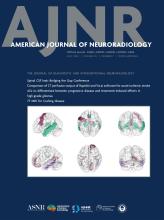Predictors of Aneurysm Obliteration in Patients Treated with the WEB Device: Results of a Multicenter Retrospective Study

Article Figures & Data
Tables
No. (%), Mean (SD) Total No. of patients 763 Sex (female) 510 (66.8) Mean age (yr) 59.9 (SD, 11.7) Smoking statusa Current 210 (31.2) Former 193 (28.7) Nonsmoker 270 (40.1) Ruptured aneurysm 230 (30.1) Aneurysm location AcomA 223 (29.2) Basilar tip 123 (16.1) ACA 56 (7.3) ICA 15 (2.0) MCA 206 (27.0) PcomA 54 (7.1) PICA 14 (1.8) ICA terminus 60 (7.9) SCA 5 (0.7) VA 6 (0.8) PCA 1 (0.1) Mean aneurysm neck (mm)b 4.0 (SD, 1.4) Mean maximal diameter (mm) 6.9 (SD, 2.4) Mean aneurysm height (mm)c 6.1 (SD, 2.3) Mean aneurysm width (mm)d 5.8 (SD, 2.1) Bifurcation aneurysms 639 (83.7) Daughter sace 215 (30.1) Vessel from aneurysm wallf 78 (10.4) Preprocedural AP/ACg None 327 (46.6) Single agent 91 (12.1) Two agents 283 (40.4) ↵Data missing for a = 90, b = 66, c = 10, d = 4, e = 351, f = 49, g = 10, h = 62.
Note:—AcomA indicates anterior communicating artery; PcomA, posterior communicating artery; ACA, anterior cerebral artery; SCA, superior cerebellar artery; VA, vertebral artery; PCA, posterior cerebral artery; AP/AC, antiplatelets/anticoagulants.
- Table 2:
Occlusion rates of treated aneurysms intraoperatively and at most recent follow-up
No. (%), Mean (SD) Mean duration of procedure (min)a 88.0 (47.9) Immediate occlusionb 100% 212 (29.2) >90% 185 (25.5) <90% 328 (45.2) Contrast stasis in nonoccluded aneurysmsc 485 (90.3) Mean duration to last follow-up (mo) 17.7 (20.3) Technique of last follow-upd DSA 206 (27.3) MRA 376 (49.9) CTA 131 (17.4) MRA/DSA 9 (1.2) CTA/DSA 5 (0.7) MRA/CTA 27 (3.6) Occlusion at last follow-upe Complete 497 (71.5) Near-complete occlusion 139 (20) Aneurysm residual 59 (8.5) Complete occlusion 497 (65.1) Retreatment 56 (7.3) Note:—Data missing for a = 113, b = 37, c = 68, d = 9, e = 68.
- Table 3:
Intraoperative degree of occlusion and stasis as predictors of long-term outcomes
Imaging Findings Management Obliteration Residual/Recurrence P Value Treatment No. Treatment P Value Intraoperative 100% occlusion 175 (85%)a 31 (15%)a <.001a 4 (1.9%)a 207 (98.1%)a <.001a 90%–99% occlusion 94 (51.4%) 89 (48.6%) 18 (9.7%) 167 (90.3%) <90% occlusion 200 (61.3%) 126 (38.7%) 34 (10.4%) 193 (89.6%) Contrast stasis 284 (59.2%) 196 (40.8%) .259 48 (9.9%) 436 (90.1%) .606 No stasis 26 (51%) 25 (49%) 4 (7.7%) 48 (92.3%) a Significant.
- Table 4:
Test parameters of intraoperative complete occlusion as a predictor of long-term obliteration and no additional treatment
Obliteration at Last Follow-Up P Value No Retreatment P Value Sensitivity .373 Sensitivity .310 Specificity .874 Specificity .929 Positive predictive value .850 Positive predictive value .981 Negative predictive value .422 Negative predictive value .102 Positive likelihood ratio 2.961 Positive likelihood ratio 4.345 Pearson χ2 P value <.001a Pearson χ2 P value <.001a ROC curve P value <.001a ROC curve P value .003a ↵a Significant.
In this issue
Jump to section
Related Articles
- No related articles found.
Cited By...
- No citing articles found.
This article has not yet been cited by articles in journals that are participating in Crossref Cited-by Linking.











